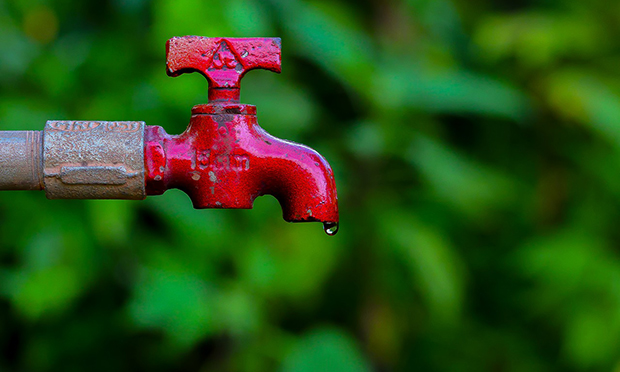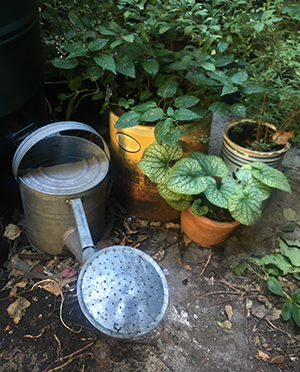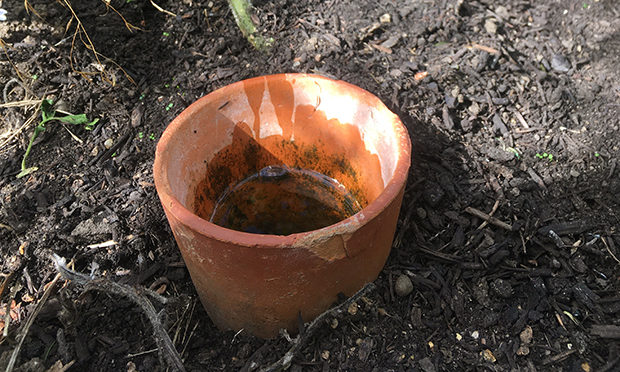The Citizen Gardener: ‘We can do our bit to save water’

We tend to think we live in a wet city and yet it is drier on average than Barcelona, Zurich and Tel Aviv. It’s the grey, perhaps, that we confuse with rain.
This is a problem because we assume that we have plenty of water but, according to a Public Accounts Committee report in July (bit.ly/312EL65), some parts of the country are likely to run out of water within 20 years if we carry on wasting it as we do.
This is partly because water companies don’t fix leaks, which account for three billion litres a day. It’s difficult to visualise that amount of water – a swimming pool? The Irish Sea? – but it’s about a fifth of our supply and it’s a problem because water companies then have to extract water from rivers and chalk streams – listen to Feargal Sharkey talk about the extinction of these dwindling sources at bbc.in/2P5POGc – to replenish supplies rather than impose hosepipe bans for example.
But wouldn’t that send the right message out: water is in short supply. Be careful. The climate is also changing and we are increasingly having drought periods (as well as flooding).
This sunny May we had less than a quarter of our normal rainfall, leaving food producers and wildlife struggling.
Most of this is beyond our control and is up to the government and water companies to fix, but we can do our bit as gardeners.
Water less and at the right time
As ever, it’s to do with the soil. If it’s full of rich organic matter, it will retain water better.
I’m quite mean with watering, even though it’s my favourite task. I try to get my plants (those in the ground) to fend for themselves and encourage strong root growth which can take up more water. I also focus my watering at key points in the plant’s growing time – at germination, when transplanting, and for fruiting veg when the flower and small fruits start to develop.

Root veg need enough water for steady growth but too much encourages lush foliage rather than root development.
Leafy vegetables like broccoli and kale require a lot of water throughout their growth – 10-15 litres per square metre per week. It’s better to give one big water a week than lots of sprinkles. That encourages roots to delve deeper to find moisture. But over-watering can be detrimental to growth. It can wash nutrients out of the soil and encourages shallow rooting. It also reduces the flavour.
Using a watering can is better than a hose. It’s a real slow, calming zen thing and you are less likely to waste water.
Don’t water lawns or large perennials. They can look after themselves.
Grow the right plants for the conditions
The vegetables that we grow tend to be thirsty – courgettes, cucumbers, beans need water to develop properly so we need to water them a lot.
We might have to start thinking about growing veg that need less water – tomatoes (if mulched), chard, chickpeas, climbing beans. Woody-stemmed herbs like sage and rosemary are good, too.
I’m thinking about not growing runner beans next year but more French beans as they seem to do better with less water. I’m also going to save seeds from those plants that did better in my minimal watering regime.
Perennial plants (those that come back each year) are also better at looking after themselves. I never water my currants, rhubarb or artichokes.
Avoid evaporation and run-off
– More water is lost through evaporation than drainage, so keep the soil surface mulched, water in the early morning or evening and in dry weather minimise cultivation – don’t hoe or move plants around.
– Plant across any slope rather than down so that plants catch runoff.
– Water gently and thoroughly. Large water droplets destroy the soil surface and can damage plants so use a fine rose on your can (upside down if possible) to replicate soft but persistent rain.
– Interplant big plants with salad leaves, calendula, chamomile – all sorts of things. In nature you notice plants are quite tightly packed. Weeds may compete for water but they also retain moisture in the soil. This is a balance you need to work out.
– Provide shade. We assume we need as much sun as possible but these days it can be scorching. You can use other plants like sunflowers. fennel or evening primrose to provide delicate shade and attract beneficial insects. Plant in blocks – eg hexagonal offset patterns rather than rows to provide shade.
– A recent tip I read is vertical mulching. You just put sticks in the ground around your plants and that helps water get into the soil rather than running off. Another one is to put a terracotta pot with the hole bunged up in the ground near, say, your tomato plant. Fill it with water. As it’s porous it will gently make the soil moist.

Growing in pots
You must water pots – probably every day – as plants can’t find their own moisture with their roots. Make sure your pots sit on drip trays to catch water. You can mulch with gravel to keep moisture in.
Sounds daft but rather than chuck half drunk (or contaminated by the cat) glasses of water down the sink I empty them into a plant pot. It’s surprising how much it adds up to.
Collect water
Plants respond better to rainwater (it’s softer than London water and doesn’t have all the chemical additives) so if you can use it rather than from the tap your plants will be stronger.
Grey water (ie. from the shower, bath, washing up) is a source of extra water but be careful what detergents and soaps you use as these can damage plants. Often washing-up water is pretty greasy so also not good for plants. My water butt provides all the water for my pots for a year.
For more tips, Gardeners’ World ran a feature about water saving (bbc.in/39Erjt8), and a lot of information for this article came from reading and following Joy Larkcom’s advice in Grow Your Own Vegetables over the years.
Kate Poland is an award-winning community gardener and the UK’s first ever postcode gardener in E5. For more, head to cordwainersgrow.org.uk and friendsoftheearth.uk
